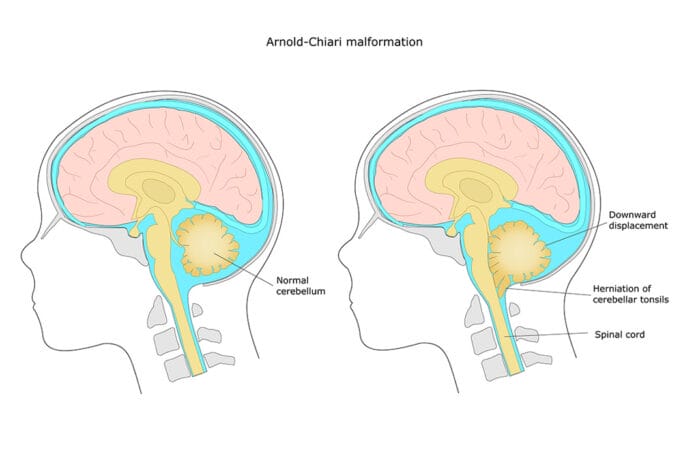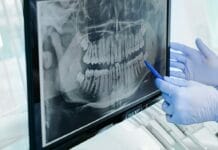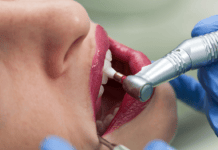Chiari malformation is a condition in which the brain tissue extends into the spinal canal. Many cases are asymptomatic and only discovered due to imaging for other conditions. However, when it is symptomatic, it can be quite painful.
It is estimated that the prevalence of Chiari malformation is around one in 1,000 people. The four types of Chiari malformation are:
- Type 1 symptoms can present anywhere from infancy to adulthood.
- Type 2 is associated with spina bifida and is present at birth.
- Type 3 is rare and associated with a high cervical or occipital encephalocele.
- Type 4 is cerebellar hypoplasia without significant relation to other Chiari malformations.
There are some subtypes as well, but that is venturing a little deep into the weeds. For the purpose of this article, we will stay focused on the type mostly encountered in the dental setting; type 1.1 Descriptions of Chiari malformation shows up in the literature as far back as 1641. However, it wasn’t until 1883 that Arnold and Chiari definitively described the condition.2,3
Chiari malformation type I is likely the type most associated with orofacial pain and other issues that would be addressed in dentistry. The exact etiology of Chiari malformation type I is unknown. However, it has been linked to genetic factors, injury, contact with harmful substances, and/or infection.1
Chiari malformation can cause patients to experience head and neck pain as well as muscle weakness that could have them seeking help from their dental provider. Here are a few things you need to know that may help you better care for your patients and get them the relief they need.
This article will focus on some specific symptoms of type 1 Chiari malformation, but additional symptoms include the following:6
- Headache, especially after sudden coughing, sneezing, or straining
- Neck pain
- Hearing or balance problems
- Muscle weakness or numbness
- Dizziness
- Difficulty swallowing or speaking
- Vomiting
- Ringing or buzzing in the ears (tinnitus)
- Curvature of the spine (scoliosis)
- Insomnia
- Depression
- Problems with hand coordination and fine motor skills
- Difficulty swallowing
- Excessive drooling, gagging, or vomiting
- Breathing problems
- Difficulty eating and an inability to gain weight
TMJ Pain
Chiari malformation type I can have symptoms that resemble TMJ disorders. This occurs due to increased intracranial pressure affecting the trigeminal nerve tract, consequently mimicking a TMJ disorder. As you can imagine, the go-to therapies for TMD may not be helpful in this case as the etiology is quite different from most TMD patients.
The treatment for patients with TMD associated with Chiari malformation usually is “expansion of the foramen magnum by decompression of the posterior cranial fossa.”2 This is a little outside the scope of practice among dentists and dental hygienists. This is an example of when we need to know our limits and know when to refer.
Patients who do not respond well to the usual TMD treatments should be referred to a neurologist to ensure there are no underlying issues that need to be addressed, such as trigeminal neuralgia and Chiari malformation. An MRI might be needed for a definitive diagnosis. It’s important to recognize when a patient needs help from another health care source.
Sleep Apnea
Airway is such a hot topic in dentistry these days, and for good reason, it can be life-changing. Most hygienists and dentists are screening for sleep apnea and other airway disorders in both children and adults. We often rely on the Mallampati score to help us decide where the patient falls on the risk scale. However, in some cases, a patient may score in the high-risk group due to soft palate muscle weakening from Chiari malformation.
In most cases, these patients would be treated with the gold standard and started on CPAP. However, if the patient has a poor response to CPAP therapy and continues to complain about sleep issues, it may be a good idea to have the patient see a neurologist to rule out Chiari malformation. In some cases, surgical correction of the anomaly and adaptive pressure support is a promising treatment option.4
Dysphagia
Dysphagia is associated with multiple health conditions, including stroke, ALS, head injuries, multiple sclerosis, and dementia. Patients may complain of difficulty swallowing certain foods, which may be an indicator of dysphagia due to an underlying condition. It’s important to mention that dysphagia risk increases with age; therefore, that must also be considered. Nonetheless, if patients consistently complain of difficulty swallowing with no clear etiology, discussing the option for the patient to be evaluated by a neurologist may be in order.
In a case study published in 2002, a 78-year-old woman complained of difficulty swallowing, which was progressing for over a year. After testing and no other neurological abnormalities were detected, the patient was officially diagnosed with Chiari malformation. Though the patient had been previously diagnosed with ALS, upon further imaging, type I Chiari malformation was discovered. It was determined the patient did not have ALS but dysphagia associated with type I Chiari malformation.
The patient underwent neurosurgical posterior fossa decompression. A six-month follow-up after surgery showed improved tongue function without aspiration upon swallowing tests. Dysphagia can occur as a sole manifestation of adult type I Chiari malformation absent any other symptoms.5
Conclusion
The sole purpose of this article is to bring awareness to Chiari malformation and how it can manifest in the head and neck. It became important to me to write about this because of a personal experience with a patient. This patient presented with constant pain and even a foul taste in her mouth. She was referred to multiple specialists before she was sent to a neurologist, where she was properly diagnosed and treated.
In my opinion, it took far too long to find the proper specialist to manage her pain, and I made a solemn promise to this patient to bring more awareness about Chiari malformation to the dental community. This article is an attempt to make good on that promise.
This patient had trigeminal involvement, but her symptoms were not the typical “electrical shock” pain. Therefore, she was referred to an endodontist to evaluate the source of her pain. The endodontist could not pinpoint the pain. It was so excruciating that the patient ended up losing a tooth before getting referred to the proper specialist.
Since then, she has undergone multiple surgeries to manage her pain and discomfort. If you have a patient that is suffering from pain that can’t be pinpointed, consider a referral to a neurologist, and add Chiari malformation to your differential diagnosis. Be aware not all patients are seeking pain medicine when they complain of pain from an unknown origin. That was certainly not the case for my patient; she needed surgical intervention to manage her symptoms.
Before you leave, check out the Today’s RDH self-study CE courses. All courses are peer-reviewed and non-sponsored to focus solely on high-quality education. Click here now.
Listen to the Today’s RDH Dental Hygiene Podcast Below:
References
- Chiari Malformation Type I. (n.d.). Johns Hopkins Medicine. https://www.hopkinsmedicine.org/health/conditions-and-diseases/chiari-malformation-type-i
- de Arruda, J.A., Figueiredo, E., Monteiro, J.L., et al. Orofacial clinical features in Arnold Chiari type I malformation: A case series. Journal of Clinical and Experimental Dentistry. 2018; 10(4): e378-e382. https://doi.org/10.4317/jced.54419
- Tubbs, S.R., Turgut, M., Oakes, J.W. (2020). The Chiari Malformations (2nd ed. 2020 ed.). Springer. https://doi.org/10.1007/978-3-030-44862-2
- Fahim, A., Johnson, A.O. Chiari malformation and central sleep apnoea: successful therapy with adaptive pressure support servo-ventilation following surgical treatment. BMJ Case Reports. 2012: bcr-2012-007143. https://doi.org/10.1136/bcr-2012-007143
- Paulig, M., Prosiegel, M. Misdiagnosis of amyotrophic lateral sclerosis in a patient with dysphagia due to Chiari I malformation. Journal of Neurology, Neurosurgery, and Psychiatry. 2002; 72(2): 270. https://doi.org/10.1136/jnnp.72.2.270
- National Institute of Neurological Disorders and Stroke. n.d. Chiari Malformation Fact Sheet. Retrieved from chiari-malformation-fact-sheet












